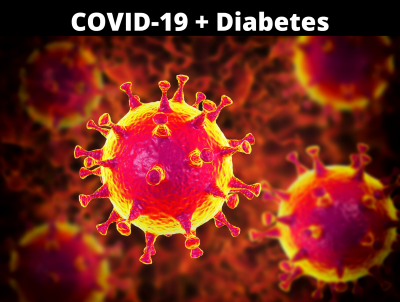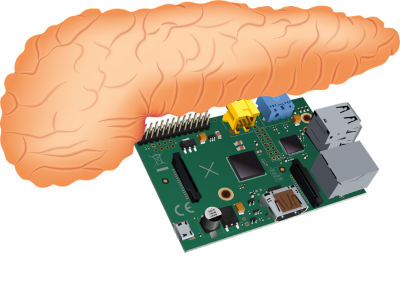November 2020
The UMB Post[doc]
November 2020
Bridges to Biotech: Making Your Way from Academia to Industry
Is COVID-19 Triggering a New Type of Diabetes?
The Artificial Pancreas: An Example of Citizen Scientists at Work
In Conversation With...Dr. Simeon Taylor
SPOTLIGHT ON: Hongxia Chen, MD
Sickness in Science: When Chronic Illness Affects Career Development
November Career Development Events
Introduction
Dear Readers,
November is World Diabetes Month - a time dedicated to increase awareness about diabetes and support the people affected by it. This year, the importance of doing so is more critical than ever, as COVID-19 disproportionately affects people with underlying conditions, including diabetes.
In this issue of The UMB Post[doc], we focus on topics around this metabolic disease: Does COVID-19 trigger diabetes? Did you know about the DIY pancreas? Are we doing enough to support academics with chronic illnesses? In career development this month, learn how to make a shift from academia to industry by reading about the Bridges to Biotech program. And just for good measure, we have thrown in some rat-humor for you as well.
Lastly, if you would like to be involved in the making of the newsletter, feel free to reach out to us at umbpostdoc@som.umaryland.edu.
Happy reading!
Best,
The UMB Post[doc]
Bridges to Biotech: Making Your Way from Academia to Industry
Archana Gopalakrishnan
The Biohealth Capital Region, including Maryland, Virginia, and DC is ranked as the 4th leading Biopharma cluster in the United States. With more than 500 biotech companies and 2,700 life science firms, Maryland has also witnessed a 700 percent increase in venture capital funding in the last few years. The State has realized that in order to grow into one of the leading biopharma clusters, the future generations need to be prepared and invested in a Maryland workplace. Thus, was born the Bridges to Biotech initiative in 2017. This multi-collaborative program is intended to provide graduate students and postdoctoral fellows an opportunity to get additional training and gain networking experience with biotech industries in the state. The participating institutes include the University of Maryland, Baltimore (UMB), Johns Hopkins University (JHU), the National Institutes of Health (NIH), and the Maryland Department of Commerce. While the academic institutes select qualified and interested applicants, the Maryland Department of Commerce identifies biotech businesses interested in connecting with academic scientific talent.
Postdoctoral trainees at UMB have been largely attracted by this program. Says Ankit Dwivedi, a fourth-year postdoctoral fellow, who participated in the program in 2019 with the Food and Drug Administration (FDA), “The Bridges to Biotech program stands out compared to other programs as it provides you an opportunity to interact directly with the employers from different departments for informational interviews and sharing your CVs for a specific open job position at FDA on the spot.” The structure of the program provides an opportunity for one-on-one interaction with the representatives of different departments to discuss job opportunities and the application process. This is a very appealing feature to aspiring scientists wanting to move away from academia.
Says Jacquelyn Serfecz, a second-year postdoctoral fellow, who also participated in the program in 2019, “The interview portion of the Bridges to Biotech program is most helpful because you get the opportunity to meet with the hiring supervisor for particular positions that suit your experience and interests." Most applicants are looking to learn more about the type of jobs that are available in the biotech sector and the ones that would match their skill sets. This program gives companies the time to have personal interactions with the applicants and explain in detail what they are looking for in a candidate. Bridges to Biotech aims to help applicants to network, to understand the process to apply for specific departments within that company, and get feedback on their CV/resume in order to improve one’s profile to make it more suitable for a specific position.
Besides the FDA, several Maryland companies have participated in this program, including Personal Genome Diagnostics, Bio Reliance, Noble Life Sciences, and Emergent BioSolutions. Success stories from these companies encourage other businesses to take notice of this unique program that presents them with a unique talent pool of skilled and passionate scientists. Jennifer Aumiller, Director of Postdoctoral scholars and GPLIS/OPS Career and Professional Development at UMB says that often times, applicants receive positions due to their participation in this program. She describes this program in an interview saying, “Each field is very different and this program gives students an idea of the different types of positions they could pursue, different roles they could have, and the difference between academia and the biotech industry.”
This past year has been a hard hit in terms of gaining experience, networking, and career advancement. However, COVID-19 did make the Bridges to Biotech program more accessible. In the past, participants often needed to travel to the host company. However these sessions are now streamed virtually, encouraging more involvement from participating companies and students/trainees. If you are a graduate student or a postdoctoral fellow looking for career opportunities outside academia and would like to learn more about the different positions and opportunities the Biotech sector has to offer, what are you waiting for? Go ahead and apply for the Bridges to Biotech program.
Is COVID-19 Triggering a New Type of Diabetes?
Sridevi Ranganathan

The COVID-19 pandemic has revealed several health inequities in our society. These include socioeconomic, age- and race-dependent disparities in exposure to disease, and access to healthcare. The pandemic's disproportionate effect on older people and people with pre-existing conditions such as cardiovascular disease, obesity, hypertension, lung disease, and diabetes are well recognized. A UK based whole-population study assessed the risk of hospital deaths with COVID-19 in ~61 million people registered with general practices in England. This study paid particular attention to the diabetic status of patients. People with Type 1 diabetes were at ~3 times increased risk of mortality upon COVID-19 infection. Those with Type 2 diabetes were at ~2 times increased risk, even after adjusting for socioeconomic factors and other comorbidities.
However, the relationship between diabetes and COVID-19 infection goes one step further.
In June 2020, fifteen physician researchers from renowned institutions worldwide endorsed a letter to the editor of The New England Journal of Medicine. This letter outlined the "bidirectional relationship between COVID-19 and diabetes." New evidence is emerging that COVID-19 infection may trigger an atypical Type-I diabetes-like disease. One, amongst many, such cases is a nineteen-year-old patient who contracted asymptomatic COVID-19 from his parents. Five or six weeks later, the patient was admitted to intensive care with a blood sugar level of over 550 mg/dL (average level in healthy patients is <140mg/dL). He had lost over twenty-six pounds in this short time frame and reported extreme exhaustion. Interestingly, the patient did not have autoantibodies typically detected in Type-1 diabetic patients but was responsive to insulin treatment.
COVID-19 is not the first instance where a viral infection triggered the onset of a metabolic disease such as diabetes. The 2003 SARS coronavirus also resulted in higher blood sugar levels and acute onset diabetes in a subset of patients. The spike glycoprotein on the SARS-CoV-2 virus binds to the ACE2 receptors on eukaryotic cells' surface to gain entry. ACE2 receptors are highly expressed on b-cells in pancreatic islets, in both mice and humans. Studies have shown that ACE2 expression, b-cell homeostasis, and the resulting insulin-dependent control of blood sugar levels are intricately connected. In mice, the deletion of ACE2 receptors resulted in higher glucose and lower insulin levels, accompanied by increased b-cell oxidative stress. Reducing ACE2 expression also led to fewer b cells in mice. Some studies suggest that ACE2 may be necessary for intra- islet paracrine communication between the pancreatic cell types. Type-I diabetes is characterized by the destruction of pancreatic beta cells by an autoimmune process. The current hypothesis is that SARS-CoV-2 destroys the pancreatic beta cells resulting in TypeI diabetes-like presentation without the autoantibodies associated with the disease. The 2003 SARS virus was shown to have a cytopathic effect on pancreatic beta cells. A study using a pancreatic organoid model showed that SARS-Cov-2 can infect beta cells in the pancreas.
Along with proving the causality link between SARS-CoV-2 infection and the onset of diabetes, many questions remain: Is this pancreatic cell damage reversible? Is viral infection-induced diabetes transient? How frequently does this occur? To study the link between diabetes and COVID19 and understand the frequency of occurrence, researchers have set up an international registry called covidab.e-dendrite, where information about patients who present with COVID19 related diabetes is reported.
The bidirectional relationship between COVID19 and diabetes warrants further investigation and will be an exciting research space to watch.
The Artificial Pancreas: An Example of Citizen Scientists at Work
Tramy Hong

Type-1 diabetes (T1D) is the result of a patient’s pancreas producing little to no insulin, a hormone required for the regulation of blood glucose. These patients need to take insulin throughout the day to ensure there is sufficient insulin to prevent high blood glucose, which can be dangerous. Patients with T1D have to vigilantly monitor their blood glucose, keep track of the amount of carbohydrates they are consuming, then calculate and take the appropriate amount of insulin to keep their blood sugar levels stable.
Becoming hypoglycemic or hyperglycemic can have serious consequences. One technology that has made it easier for T1D patients to monitor blood glucose and administer insulin is the artificial pancreas which is a single system that automatically monitors and dispenses insulin, alleviating some stress and pressure from the patient and their caregivers. While research and development into an artificial pancreas system has been ongoing since the 1960s, it wasn’t until 2016 that the FDA approved the first hybrid system that automatically adjusted insulin levels but still required patients to count and input carbohydrate intake. The system was made by Medtronic and became commercially available in June 2017.
However, tech-savvy patients have been taking things into their own hands since at least 2014. It started with Dana Lewis, a diabetic patient, and her network engineer partner, Scott Leibrand. Together, they figured out a way to develop an algorithm that could predict how much insulin a patient would need, which would act as the link between the blood sugar monitor and the insulin dispensing device. The final piece of the puzzle was provided by hacker Ben West, who discovered that certain, older models of Medtronic insulin pumps had a security flaw that would allow it to receive external commands. In December of 2014, Lewis and Leibrand “closed the loop” by connecting a Medtronic insulin pump to a continuous glucose monitor via a small computer running their custom software. The pair continued to refine their system and even published instructions for other patients who want to make their own on their website OpenAPS.com.
Despite the current availability of several artificial pancreases on the market, OpenAPS estimates there are at least 2,000 users world-wide that still choose to use the DIY version. Dana Lewis predicts that the DIY era of the artificial pancreas will not be ending any time soon. One reason is cost. Despite the possible challenges in finding the right components, the typical cost of a DIY system is less than $1000. The Medtronic system costs around $7000, some of which could be covered by medical insurance. Another reason people choose not to switch to the commercial version is control. Diabetic patients are used to having total control over how much insulin they need and the DIY version allows them to maintain that level of control and make fine-tune adjustments, when necessary. With the commercial product, there is less transparency and personalization. Finally, there is the rate of advancements. The DIY systems do not have to comply with federal regulations. As a result, new and improved and features are more quickly and readily available.
As research scientists, we understand how long research and development can take. This, coupled with the, oftentimes, arduous route of FDA approval means that it could take several years before essential therapeutics become available. For some, this is time they don’t have. The DIY artificial pancreas gave diabetic patients the tool they needed sooner and with more control. And it could not be done without people, like Dana Lewis, who were brave enough to do their own research and take matters into their own hands.
Currently, Dana Lewis has used her DIY platform to become a “citizen scientist.” She started a Data Commons that allows people to donate their data anonymously, making a significant amount of data easily available and accessible, and is currently collaborating with researchers at Arizona State University to study the ways citizen scientists can contribute to scientific research. Citizen Scientists are “laymen” who work with scientists to collect, analyze, and report data. This allows scientists wider access than they were able to reach before as well as give people a voice in the direction of scientific research. After all, Dana Lewis and the DIY artificial pancreas community has shown that they know best when it comes to research that affects them. By pivoting away from the “expert-driven model,” people can become involved in research that could potentially impact themselves and their communities.
In Conversation With...Dr. Simeon Taylor
Shannon Cole

Here, I interviewed Dr. Simeon Taylor, an expert in diabetes and metabolic disease. Dr. Taylor has had a career spanning fifty years with wide-reaching experiences providing an understanding of many of the challenges and successes in diabetes research. Dr. Taylor worked as a member of the intramural program at NIH/NIDDK for twenty-one years, largely working to understand molecular mechanisms mediating the effects of insulin target cells and the genetics of diabetes. In 2000, Dr. Taylor transitioned from academia to the pharmaceutical industry, working at both Eli Lilly and Bristol-Meyer Squib for thirteen years where he was responsible for the creation of a number of drugs for the treatment of diabetes and atrial fibrillation. At UMB, Dr. Taylor has focused on pharmacogenomics and translational models in diabetes research. We discussed advancements in the field of diabetes research and current issues in treatment, both related to obesity and the going COVID-19 pandemic.
Q: What incentivizes you on a daily basis?
I am very interested in what makes different people different in terms of how they respond to drugs…I am particularly interested in “why does one person respond to a drug with a big benefit, why does one person respond with less benefit, and why does one person get a devastating toxicity and another person doesn’t have any safety issues?” To me, those are both practical and theoretical questions. I am interested in the intellectual challenge of trying to answer those questions, but also the practical impact of being able to predict that before somebody has a bad side effect.
[In alignment with those interests, at UMB Dr. Taylor has been largely involved with the field of pharmacogenetics, with the idea of providing personalized, precision, or stratified medicine.]
In an ideal world, you could measure genetic variance and say “this is a patient who is likely to get a big benefit and unlikely to have a risk of safety problem”, so we are interested in variances that are associated both with the beneficial response and the undesired responses…The concept of giving drugs that work rather than drugs that don’t work, and that the same drugs don’t work equally for everybody—that’s not a new concept. This concept is sort of “good medicine” that you want to give someone a treatment that is going to work for that person rather than a treatment that won’t.
…Of course, in some cases you really learn new insights into biology. For instance, if there’s a gene that affects a response to a drug in addition to being of practical value, it sometimes opens up a new area of biology that you haven’t appreciated.
Q: What do you consider to be the greatest advancements for diabetes prevention and treatment in the last twenty years or so?
In the 1990s there were some landmark studies demonstrating that improved control of glucose, getting near normalized glucose…it has a remarkable and beneficial impact in decreasing the risk of diabetic complications, such as blindness, amputations, kidney failure, etc.
So, probably the single biggest was proving that controlling glucose actually mattered. Believe it or not, that was actually quite controversial prior to that time. Although there were people that believed it, there were many that didn’t believe it. I think the proof that this is the case has really helped people to focus on how you control glucose.
In type-1 diabetes, the autoimmune form of diabetes that’s only about 5 percent in the US, but is often the most dramatic and occurs in childhood, there have been huge advances in technology that have made the treatment better; ranging from the ability of patients to measure their own blood glucose…more recently to have non-invasive technology that lets you measure continuously your own blood glucose.
Also, technology in terms of genetic engineering, to make improved quality of insulin, and not only to make natural insulins too, but to change amino acid sequence to optimize the insulin for performance as a drug, and insulin pumps to deliver insulin. Now, increasingly progress made connecting glucose monitors to the pump and having computer-based algorithms that will take information on the glucose level and automatically match delivery the need. So, even though it’s still an incredibly difficult disease to have or manage, the technology has just improved dramatically.
In type-2 diabetes, the more common form associated with obesity, I think the proliferation of drugs and increasingly safe drugs, and also drugs that have been shown to decrease the risk of cardiovascular complications, like heart attacks, strokes, and death. But, this isn’t any one single advance, but it’s just that there are so many more medicines available and they’re so much better than the ones available in the last century so that you can begin to have a real pact on blood sugar, [and] the outcomes such as blindness, kidney failure, amputations, and now, cardiovascular disease.
So, this hasn’t been any one single advance, but the combination of thinking glucose matters and thinking that it matters if you whether you have really good drugs or less good drugs. But I think for both type-1 and type-2 there really is progress.
Q: What are the current barriers to diabetes treatment?
Unfortunately, the area that continues to be the most challenging, especially in type-2 [diabetes], is obesity. Ultimately, it just turns out that many people eat more and exercise less than is good for their health. It’s just such an incredibly challenging area. In terms of health, I think if there could be progress made on getting people to achieve ideal weight, it would continue to have an enormous impact on public health.
To me, it’s a bit like “I can hold my breath and stop breathing for a time, but I cannot do it for a week I need to breath”. And for many people, even if they can lose weight for a month or a year, it turns out it is just very difficult to sustain that weight loss.
It turns out the drugs that have been worked on either have modest efficacy on obesity or have safety issues or both. It has just been a very challenging area even though there has been some progress made it has been relatively slow progress. Whereas, I think there has really been excellent progress in drugs to treat diabetes, just much less progress in terms of weight loss and weight management.
Q: Would you say in general that it’s more of a behavioral problem?
Well, I’m not sure that is a fair dichotomy…I think that eating is a very basic drive. It’s like breathing. But it turns out that some people, perhaps most people, if given free access to food will eat more than is optimally healthy and most people will exercise than is optimally healthy. That combination has just not worked out very well in countries like the United States.
Q: Would you say that’s the biggest barrier to treatment?
Well, with type-2 diabetes, if you could solve obesity, you’d make real end roads into treating diabetes. The thing that is so frustrating that is it isn’t that hard to lose weight, but it is hard to sustain the weight loss. You know, there’s this joke “It’s easy to lose weight, I’ve done it a hundred times.” And that’s sort of true; it’s not easy. And some people don’t have the problem at all. Their appetite is somehow much more aligned with physiological cues, and in other people, this sort of “hedonic drive” of eating is very strong and not as focused on the physiological/homeostasis related to bodyweight.
Q: With the ongoing pandemic there is a certain impairment to the accessibly to medical care. Is there anything within the diabetes research community that is being promoted or are there any low-cost treatments that people can take that they might be unlikely to know?
I do think that fortunately many of the needs of patients with diabetes can be dealt with in a telehealth context…It is clear that obesity and diabetes are risk factors for bad outcomes with COVID…I think the combination of increasing ones exercise and trying to pay attention to what we eat that can have a beneficial impact on health, particularly in the context of COVID, but also in a more general context.
The main thing I think would be good for many people, not uniquely now, is to try to incorporate healthy behaviors into one’s life.
SPOTLIGHT ON: Hongxia Chen, MD
Long Jiang

This month, we interviewed Hongxia Chen, MD, a postdoctoral fellow at the UMB School of Medicine, Center for Vascular and Inflammatory Diseases, in the laboratory of Dr. D Li Zhang. She has fifteen years of clinical working experience as an endocrinologist in China. Here, she shares with us her experience in the field of diabetes and some suggestions on how to avoid developing type-II diabetes in this pandemic period.
Q: How long have you been at UMB and what made you want to come to the United States?
HC: I have been at UMB for nearly two years. I was originally an endocrinologist in China. I have been in clinical work for nearly fifteen years. Every year, I see a large number of patients with prediabetes, diabetes, and diabetes with one or more complications. My main focus is on clinical work and I found I lack the scientific thinking. The United States invests a lot in medical research compared to other countries, and this University’s research on lipid metabolism, cardiovascular, and cerebrovascular diseases is relatively well-known, so I chose to come here as a postdoc to further study. I hope that I can use scientific research thinking in my future clinical work to further understand the discipline of disease occurrence and development, and contribute to alleviating or relieving the suffering of patients.
Q: What’s your main research area now?
HC: My current research field is diabetes combined with cardiovascular and cerebrovascular diseases, and the main scientific research project I undertake is the role of macrophages in the occurrence and development of this disease. We know that diabetes can also be regarded as a kind of chronic inflammation. Whether it is the congenital islet cell damage of type-1 diabetes or the acquired insulin resistance of type-2 diabetes, it is related to the impaired function of islet cells. This damage can be attributed to acute or chronic immune damage of islet cells, and macrophages occupy a very important position in the immune system. What role do macrophages play in the development of diabetes? I am very interested in the current research.
Q: Do you know there are a lot of programs for the career development of postdocs in UMB? Have you joined any of these programs yet?
HC: Yes, I know there are several programs for the career development of postdocs as received by emails. But I only joined one training about “Identifying Funding Sources for Postdocs”. This is a fantastic training. Before this, I have no idea about how to find and apply for a funding. This workshop gave me a lot of useful information. It is very helpful for those postdocs who want to apply for some funding. Hope I will have more time to join other trainings like this.
Q: The theme of this month’s newsletter issue is about “Diabetes” in light of World Diabetes Day in November. You were an endocrinologist in China. Can you talk about the current status of diabetes in the United States?
HC: From results of “National Diabetes Statistics Report, 2020” by CDC’s Division of Diabetes Translation, 34.2 million Americans (>1/10) have diabetes and 88 million American adults (~1/3) have prediabetes. Although new cases significantly decreased from 2008 through 2018, yet there is a significant increase in new diagnoses in youth cases of both type-1 and type-2 diabetes. Therefore, we can see more and more young people have developed diabetes in recent years. We should pay more attention to this population.
Q: What are the current advances in research in this area?
HC: For researchers working on diabetes, recent studies mainly focus on the sodium-glucose co-transporter 2 (SGLT2) inhibitors. The SGLT2 is mainly expressed in the proximal tubule, it mediates reabsorption of ~90 percent of the filtered glucose load. SGLT2 inhibitors can promote kidney glucose excretion, thereby moderately reducing blood sugar levels in patients with type-2 diabetes. One placebo-controlled trial of ertugliflozin showed that ertugliflozin was noninferior to placebo in major adverse cardiovascular events among patients with type 2 diabetes and atherosclerotic cardiovascular disease. 1 Another meta-analysis study included a total of six randomized, placebo-controlled cardiovascular and kidney outcomes trials of SGLT2 inhibitors in patients with type-2 diabetes, the results showed SGLT2 has the greatest benefit for a reduction in risk for hospitalization of heart failure and kidney disease progression. In addition, one population-based cohort study including more than 350,000 patients and showed SGLT-2 inhibitors were associated with an almost three-fold increased risk for diabetic ketoacidosis. 2 To sum up, SGLT-2 inhibitors may have some clinical benefits for patients with diabetes, but also have some side effect. We are looking forward to hearing more studies to prove its effect on clinical use.
Q: Do you think people with diabetes are more vulnerable to contracting COVID-19?
HC: In my clinical experience, due to impaired regulation of blood sugar production, various organs of the body are damaged to varying degrees, and immunity and resistance are significantly reduced, diabetic patients may have a higher infection rate than non-diabetic patients of the same age. But there is not enough data to show whether people with diabetes are more vulnerable to COVID-19 than the general population. Current evidence suggests that diabetes is reported as a significant predictor of morbidity and mortality for COVID-19. No conclusive evidence exists to support the discontinuation of angiotensin receptor blockers, angiotensin-converting enzyme inhibitors, or thiazolidinediones because of COVID-19, in people with diabetes. 3 However, there is a hypothesis suggested that people with uncontrolled diabetes might be at a high risk of reinfections with COVID-19 because of the impaired adaptive immune response. 4
Q: Can you give some suggestions to prevent diabetes for post-docs in this special pandemic period?
HC: Of course. First and most important, I suggest to strictly follow CDC’s recommendations, such as maintaining a six-foot social distance. Second, adjust what you eat. During the epidemic, when we want to improve our immunity, it is very important to take in amino acids in food, especially essential amino acids, because these amino acids are the basic structure that our body transforms into various physiological hormones, such as peptides, hormones (pituitary hormones, insulin, glucagon, steroid hormones, etc.. So, we have to increase the intake of meat and eggs. Regarding the intake of sugars and lipids, it is still based on less sugar, oil, and salt. Third, increase aerobic exercise. Outdoor sports are currently limited, so do more indoor sports. Such as jogging, yoga, aerobics, etc., Thirty minutes to one hour a day is appropriate. Not only can it reduce the stress in life and work, but it can also help maintain a happy mood. Last but not least, keep your weight in the ideal range, or be slightly overweight. You can refer to related books.
1. Cannon CP, Pratley R, Dagogo-Jack S, et al. Cardiovascular Outcomes with Ertugliflozin in Type 2 Diabetes. N Engl J Med. 2020;383(15):1425. Epub 2020 Sep 23.
2. Douros A, Lix LM, Fralick M, et al. Sodium-Glucose Cotransporter-2 Inhibitors and the Risk for Diabetic Ketoacidosis: A Multicenter Cohort Study. Ann Intern Med. 2020;173(6):417.
3. Hussain A, Bhowmik B, do Vale Moreira NC. COVID-19 and diabetes: Knowledge in progress. Diabetes Res Clin Pract. 2020 Apr;162:108142.
4. Rimesh Pal, Mainak Banerjee. Are people with uncontrolled diabetes mellitus at high risk of reinfections with COVID-19? Prim Care Diabetes. 2020 Aug 7;S1751-9918(20)30238-2.
Sickness in Science: When Chronic Illness Affects Career Development
Rebecca Walker

According to the Centers for Disease Control and Prevention (CDC), a chronic condition is any prolonged or reoccurring condition that lasts a year or longer and requires ongoing medical attention or limits daily living. Chronic conditions can be unseen, such as diabetes, hepatitis C, arthritis, and asthma, or they can be overt, such as ALS, loss of vision, or conditions requiring a wheelchair. These conditions affect a large proportion of the population and can disrupt many aspects of life. So how do disabilities, chronic conditions, and persistent illnesses affect life as a scientist? Is it possible to have a career in science while managing a long-term condition?
There are many considerations for individuals with chronic conditions while navigating the science world. Several scientific careers are flexible and varied, meaning that scientific minds can apply themselves to less physically demanding roles such as bioinformatics and data analysis either full time or when chronic conditions flare up. Some conditions make us have good days and bad days. Someone with chronic fatigue may find that exerting themself on one day leads to needing several days of rest to recover. Conditions like irritable bowel syndrome may flare up unexpectantly. There can be a lot of surprises associated with chronic conditions that require flexible schedules. This is one thing that science careers have as an advantage. A good tip is to know how to prioritize tasks and how to recognize when your body will need to recover after exertion.
If we have learned anything from 2020, it’s that we are very adaptable and that having good planning skills is essential to managing our workload. These skills are things that people with long-term conditions probably mastered long before 2020 descended on us. This year has also taught us that we are able to do a lot from home. Principal Investigators (PI) should be able to see that short periods of working from home can be a legitimate way to manage a science career and a long-term illness simultaneously. A data-focused position could be a great option for a scientist who needs to work remotely. Perhaps in the future, we will see working from home become a more normal element of many careers.
Despite this, chronic illness can still pose difficulties because scientists are like nomads that roam from one lab to another or even one country to another. We often change location meaning that we also need to change our doctors. Finding a good doctor can be difficult and starting afresh each time you have to explain your symptoms can be tiring. Some good advice is to make sure you have all your records on hand because it is not always easy to rely on the system to allow your medical record to follow you.
For many in a new position or with a new illness, the question of whether to reveal or not can be a tough decision. Do I tell my employer I have a condition where I may have to take some days working at home and risk being given the project no one wants? Do I tell my lab mates that I am not able to do physically demanding tasks and risk them thinking I’m just lazy? Finding the line between advocating for yourself and coming across as a pain in the neck can be a little tricky.
With the possibility of backlash from your employer or from other lab members, it is important to know your rights. You could be worried about speaking up to ask for time off when you have already exceeded what is normally provided in your contract. You could be wondering who to talk to in order to report that you were unable to access a lecture hall in which you were supposed to give a talk because you use a wheelchair. Finding support can be hard, especially when it is not always obvious where to look.
Federal laws include the Americans with Disabilities Act and the Rehabilitation Act of 1973. Both of these acts prohibit discrimination based on disability. This University provides support through disability services for students, or through human resources for postdocs and faculty. The Americans with Disabilities Act steering committee is committed to championing diversity at UMB, they also deal with requests to make changes to the workplace or work requirements to accommodate persons with disabilities.
Being a part of a community that offers support is very important for all of us. Whether that is a supportive PI and good lab mates, our family and friends, or a social media community, we all need people who offer support when times are rough. Those with a long-term illness can be caught between the feeling of being useless and being proud of accomplishing a lot when so much is against them. Sharing your journey as a blog or just with peers as you go along can be a good way to encourage other scientists with illnesses to see that a science career is manageable for someone in their position. Check out #disabledAndSTEM or #chronicallyacademic on Twitter for more ideas.
What can those without long-term illnesses do to support their colleagues?
There are many things abled bodied people can do, ranging from being a caring lab member to advocating for your colleagues when you see an issue with the way things are run. You could ensure that you learn how to use a microphone properly when you give a talk at a conference and always insist on using one for the sake of those with hearing problems. You can make your slides accessible to those with color blindness or make sure there is enough written description for those who cannot hear what you are saying. Being a supportive team member can make the world of difference to someone who is struggling through the day and who may be wondering whether staying in science is worth it. Being someone who is supportive and approachable, who offers help with lab tasks and is not judgmental when illness affects the time in the lab, can be very helpful. Sometimes we do not know the extent of what others are dealing with but keeping our eyes open for ways to care and work together can make such a difference.
I’m going to try to be thankful for the way my body works and try not to take my body for granted!
November Events
GPILS/OPS Leadership Skills Workshop: This series will cover introductory concepts of leadership. It is recommended to take the entire series as the workshops build upon each other. November 9th, Noon. *
Increasing Your Scientific Visibility Through Social Media: This session will discuss different social media platforms available (including Twitter, Facebook, Linkedin) and considerations for maintaining a successful online presence. November 10th, 9 a.m. *
Diagnostic Radiology & Nuclear Medicine Grand Rounds / On Growth, Success, and Well-being in Academia: Diagnostic Radiology & Nuclear Medicine Grand Rounds / On Growth, Success, and Well-being in Academia. November 11th, 12:30 p.m. *
Center for Advanced Imaging Research (CAIR) Imaging Science Seminar: Flow-Suppressed Metabolic Imaging of Hyperpolarized [1-13C] Pyruvate in the Healthy Rat Brain In Vivo / SPEAKER: Minjie Zhu. November 13th, Noon. *
GPILS/OPS Leadership Skills Workshop: This series will cover introductory concepts of leadership. It is recommended to take the entire series as the workshops build upon each other. November 16th, Noon. *
Funding Success at the National Science Foundation (NSF): This seminar will focus on grantsmanship and funding opportunities offered by NSF. November 17th, 1 p.m. *
Ethical Considerations in Authorship including how to determine authorship: This session will discuss modern trends in authorship and ethical considerations when determining authorship. November 19th, 9 a.m.
VIRTUAL Scholarly Writing Accountability Groups (SWAG): The Research Career Development Program (RCDP) is offering a NEW VIRTUAL peer accountability/support program designed to increase writing productivity among UMB early stage faculty. November 30th, Noon. *
*Please check your inbox for emails with more information and registration links for these events.
Postdoc Achievements
Archana Gopalakrishnan
Cali A. Calarco, PhD

Dr. Calarco is a postdoctoral fellow in the laboratory of Dr. Mary Kay Lobo, in the Department of Anatomy and Neurobiology. She studies the role of cellular metabolism and mitochondrial dynamics in regulating nucleus accumbens medium spiny neurons as relating to reward processing. Since she joined Dr. Lobo’s lab in 2018, Dr. Calarco has been instrumental in the publication of several scientific manuscripts, has been invited to present her work in various meetings and conferences, and has been the recipient of an institutional T32 training grant. This year, she was selected for the NIH Outstanding Scholars in Neuroscience Program (OSNAP). Besides research, Dr. Calarco has also invested her time in mentoring volunteers and undergraduate students in her lab, served as a guest lecturer for a neuromethods course, and is a contributing author to the UMB Post[Doc] newsletter. She is on the organizing committee for the Program in Neuroscience Seminar series and is a member of the Trainee Advisory Committee at the Society for Neuroscience. Dr. Calarco has also volunteered with the Neuroscience Outreach Volunteer Association (NOVA) Open Labs as a Lab Tour Host and was an active participant during the Brain Awareness Week local classroom visits. NOVA is a student-led outreach group whose mission is to promote brain awareness within the Baltimore community by engaging UMB professionals with high school students.
Parikshit Moitra, PhD

Dr. Moitra is a postdoctoral fellow in the laboratory of Dr. Dipanjan Pan, in the Department of Pediatrics, Center of Blood Oxygen Transport and Hemostasis. His research is to study the development of novel biomaterials/biomedical devices for the application in modern-day theranostics targeted towards different infectious diseases, breast cancer, and as an alternative to artificial red blood cells. He was recently awarded the 2020 GPILS/OPS Postdoctoral Fellow Excellence in Research Award. Dr. Moitra has contributed towards four publications from his lab in the past year. He has also been invited to present the findings from his studies at the Biomedical Engineering Society (BMES) 2020 Virtual Annual Meeting. His work related to developing a rapid COVID-19 test using nanoparticle technique has been highlighted in the media. Dr. Moitra was also part of the team that developed the technology for the selective point-of-care plasmonic detection of SARS-CoV-2, licensed by the Office of Research and Development at UMB. Dr. Moitra has also been instrumental in the application of five distinct US patents that were submitted by his lab this year.
Laughing Rats Are Optimistic
Pavlos Anastasiadis

“Let's not forget that the little emotions are the great captains of our lives and we obey them without realizing it,” Vincent van Gogh once wrote. Emotions have a strong hand in influencing our bias toward decision-making across the entire spectrum of our daily lives. They may dictate the holiday flavor we choose for our latte or determine whether we take a mostly optimistic or pessimistic stance toward the world. Emotions are the reason why Wolfgang Amadeus Mozart and Ludwig van Beethoven composed symphonies or Friedrich Schiller and Edgar Allan Poe put their pens to paper to write poems that have inspired generation after generation. Emotions drove humans to draw cave paintings some forty-four millennia ago during the Upper Paleolithic Art Era found in the Franco-Cantabrian region in Europe and in the district of Maros in Indonesia; emotions were the culprit behind Michelangelo’s and Picasso’s creations, enthusing legions of admirers with their paintings. The link between emotional states and how they act as drivers governing human decision-making has been thought to be unique to humans. Or has the web of our emotions blocked our sight from recognizing the interaction between emotions and decision-making in other species? Only recently have our colleagues from the neuroscience field produced evidence that similar patterns likely exist in other species beyond humans and nonhuman primates.
In an effort to shed more light on how emotions and decision-making are intertwined, Rygula et al. followed up on the tickle-induced “rat laughter” study reported by Panksepp and Burgdorf back in 2000. The researchers attempted to demonstrate affect-contingent judgment bias by measuring emotions in rats. Toward this end, the team trained rats to press a lever in response to an acoustic signal associated with food reward and, conversely, another lever in response to a tone linked to a slight electric foot shock. As soon as rats demonstrated a clear discrimination performance, the animals were subjected to tickling to which rats responded with short 50 kHz ultrasonic vocalizations or “rat laughter”. Since the human audible range dwindles around the 20 kHz mark, the scientists used an ultrasound heterodyne bat detector microphone, a device that is frequency-tunable, converting ultrasonic signals to signals that fall within the human audible frequency range (approx. 20 Hz to 20 kHz). The high-frequency ultrasound chirps at 50 kHz in response to playful somatosensory stimulation (e.g., tickling) provide evidence of a positive affective state and decision-making that may provide insights into understanding the emotional-cognitive changes associated with mood disorders. The optimistic bias observed in the study indicates that, after laughing, the rats may exhibit an increased expectation of reward (e.g., increased response to the positive lever) and a decreased expectation of punishment (e.g., decreased response to the negative lever).
By unmasking the science of rat giggling, we may ultimately learn more about the workings of human behavior. During the distressing times of a global pandemic, this knowledge may even provide a playbook of how we could reinforce our perseverance and adopt an optimistic approach, reminding ourselves that spring will succeed the dark pandemic winter months that lie ahead of us. As the saying goes … laughter is the best medicine, even at times of unspoken tragedy and the paroxysm of a global health crisis.
